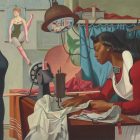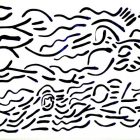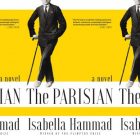Finding Communion in Disability Poetics
 I was ten years old the day I discovered I was being watched. Sitting on the steps of the altar at church with the other children, I stroked my stockinged legs, engrossed by the soft nylon against my palms, the way they shimmered in the summer sunlight. After Mass, my father took me aside. “You’ve got to be careful about what you do in public,” he explained. “You’re getting to be a young lady now. People are watching.” My cheeks reddened with the horror Eve must have felt when she realized she lived under observation. That was the day I learned what it meant to walk through the world as a woman, constantly visible.
I was ten years old the day I discovered I was being watched. Sitting on the steps of the altar at church with the other children, I stroked my stockinged legs, engrossed by the soft nylon against my palms, the way they shimmered in the summer sunlight. After Mass, my father took me aside. “You’ve got to be careful about what you do in public,” he explained. “You’re getting to be a young lady now. People are watching.” My cheeks reddened with the horror Eve must have felt when she realized she lived under observation. That was the day I learned what it meant to walk through the world as a woman, constantly visible.
When my chronic illness first appeared in my early 20s, I became conspicuous in an entirely new way. If young ladies should be seen and not heard, that goes double for young ladies with disabilities. When your body declares itself Other, your personhood fades behind it. So mine did, until I discovered disability poetics. Grappling with the changes my illness wrought, I found myself again in work that stared back in solidarity.
Disability poetics, or “crip lit,” visibly emerged in 1986, with Towards Solomon’s Mountain, the first known disability poetry anthology, edited by Joseph L. Baird and Deborah S. Workman. Although writers with disabilities had been producing work for decades, that anthology defined the genre as one that addressed their experience without eliciting sympathy. It also directly calls for visibility and consideration for the genre as a category, in its own right. Together with seminal anthologies Despite This Flesh by Vassar Miller and Staring Back by Kenny Fries, the movement eschews both sentimentality and the heroic or inspirational tropes that often shroud disabled characters in mainstream media. As Jim Ferris explained in a 2007 Wordgathering essay,
Disability poetry can be recognized by several characteristics: A challenge to stereotypes and an insistence on self-definition; foregrounding of the perspective of people with disabilities; an emphasis on embodiment, especially atypical embodiment; and alternative techniques and poetics.
Many disabled poets also ascribe to the social model of disability, which emphasizes that disability is not an inherent “defect,” but is instead a reckoning with a set of barriers—both physical and behavioral—that have been erected and perpetuated by society. Being rendered disabled by the laws and structure of the world in which we live can feel isolating for its targets. It’s also damaging for society at large.
While the passage of the Americans With Disabilities Act in 1990 made great strides toward equality, disabled people still live on the margins, of the population and media. As such, most of us don’t recognize the hostility the world harbors toward the disabled until we face limiting factors ourselves. As a genre, disability poetics enables readers with different abilities to see themselves portrayed in a clear, unsentimental way. It also gives voice to a population that mainstream society often tokenizes, while acting as a driver toward social change. I found the genre, like I suspect many do, at the very moment when I needed that guidance the most.
I began working with Fries as an MFA candidate at Goddard College in 2011. That same year, I also read The History of My Shoes when my body took a sharp left into uncharted territory. My skin rippled with myriad pinpricks and my joints sparkled with invisible electricity. The ground buckled and waved as vertigo washed over me like tides controlled by a vengeful moon. I was unmoored, and completely unprepared to weather the storms taking place within my own skin. As I adjusted to their unpredictability, Fries’s meditations on his own body taught me a new way to think about mine.
The History of My Shoes is part travelogue, part Darwinism lesson, part memoir, in which Fries explores the idea of disability as a kind of adaptation. That approach felt both refreshing and revolutionary as I struggled to navigate a medical community that addresses any difference as an obstacle to overcome. Not all illness can be eradicated; nor should every variation, lest we lose the diversity that makes our population so rich. Disability poetics presents a radical alternative to extermination—acceptance.
Fries writes that his shoes, like disabled people moving through a world not made for them, “can adapt to the circumstances in which my body places me.” While flickers of unexplained pain and vertigo had first appeared several years before, my symptoms flared dramatically when I started graduate school. Reading Fries, I considered for the first time that my body wanted something from me other than a diagnosis. Maybe, I thought, it was simply rebelling against the environment imposed on it.
“You’re too young to be in this kind of pain,” my primary care doctor said, her brow furrowed in frustration. She all but tossed the latest round of test results at me. MRI: Normal. Blood panel: Normal. CT scan, EKG, EEG: Normal. Normal. Normal. “I don’t know what to do with you,” she said. When specialist after specialist could not explain what my body wanted to tell me, disability poetics helped me adjust my perspective.
That required challenging the way I thought about disability. One-dimensional inspiration vehicles like A Christmas Carol’s Tiny Tim and grotesque caricatures like The Hunchback of Notre Dame’s Quasimodo teach us that disabled characters should be pitied or feared. Disability poets push back against that assumption by speaking their own truths, often in ways that challenge society’s conventions.
Confessional poet and activist Sheila Black’s essay, “Waiting to Be Dangerous: Disability and Confessionalism” in the anthology, Beauty is a Verb: The New Poetry of Disability addresses the way those prejudices affect her as a confessional poet and a disabled woman. She writes, “I have suffered more from other people’s perceptions of my condition than I have from my own real ‘disabilities.’” She further notes that confessional poetry “allows feeling and extremes of feeling within an ideological context, but one which is inherently unstable, one in which the message is never entirely anchored.”
When I first realized my body would never be the same, I initially grieved the person I thought I’d lost. But the more I grappled with my own internalized misconceptions, the more I realized my illness actually admitted me into a new, unexamined reality with complex privileges and contradictions I’d never understood before. Instead of the prison I previously assumed disabled bodies foisted upon their inhabitants, I learned to look at mine as a new kind of embodiment I could fully inhabit by adopting a mindset that emphasized my personhood first and my physicality as a simple, neutral fact.
However, just as the narrator is frequently distrusted in confessional poetry, so too are disabled people so often registered, but not considered legitimate, complex characters. Disability poetics challenges that concept by providing a vehicle for self-expression, on our own terms. In so doing, it pushes back at the very assumptions on which our treatment of disability is based. That push does not come without friction.
The more visible I make myself, the more society asks me to defend my position. I dread requests to answer for myself like my body puts me on trial. I also suspect that, like catcallers don’t, those interrogators aren’t really seeking a substantive answer. When someone asks, “What’s wrong with you?” it comes from a place of fallibility. They want reassurance that whatever rendered me invalid won’t assault them, too. The very question disregards the subject’s humanity, just like catcalling does.
Black writes, “Often the dilemma for the disabled poet is how to say what you truly mean in a context in which disability is either silenced and denied, or conversely, given such overwhelming importance that the human being becomes subsumed by his or her condition.” Like confessionalism, disability poetics allows the speaker to subvert expectations. It taught me that I can write about my body without letting it speak for me, bringing both of us more fully into the conversation. Disability—like gender—does not have to define us. We are so much more than blood, bone, and brain.
In the preface to the same anthology, Jennifer Bartlett writes, “mainstream writers tend to reflect the predominant view of disability as tragedy. We wanted to avoid this norm, not because it isn’t valid, but because we are interested in investigating an alternative.” Presenting disability without that sentimentality drives the genre’s reach toward equality, as does focused activism against siloing disabled people in a separate class unto ourselves. When I found writer and activist Karrie Higgins, I discovered just how powerful raising our voices against that system can be.
I first read Higgins’s essay “Strange Flowers” when exploring the degree to which trauma had caused my body’s own rebellion. I was struck by the parallels she draws between abuse and illness, nature and nurture, where we are planted and the ways we blossom. She writes, “Our bodies carry the sins of our parents like microscopic marks of Cain, secret scarlet letters …[they] blot out genes with the black ink of methyl groups, CH3, when environmental insults make adaptation necessary. Beatings, sexual abuse, malnutrition, pollution—the insults are endless.” Much like Fries and Black, her work addresses disability not as a trope, a “blessing,” or a “curse,” but one facet of a complex character she neither dismisses nor unduly elevates.
Higgins also turns disability rights activism into art until the lines blur between them. Her current series, Losing Propositions, involves seeking legal reparations for ADA abuses in cases she’s unlikely to win. In so doing, she thrusts the social disability model before those in power, demanding if not action, at least a hard look at the assumptions that perpetuate inequality. We need voices like Higgins to speak truth to power, to refuse secondary citizen status.
I rarely wear nylons anymore, but I remain as conspicuous as ever. Disability poetics creates a more empowering kind of visibility for its readers and participants. It also provides a mast by which I can sail a ship I’m still learning to navigate, as well as a destination toward which we can all steer in solidarity. It provides entry into a realm of experience we so often disregard until, inevitably, we or our loved ones join its ranks.



